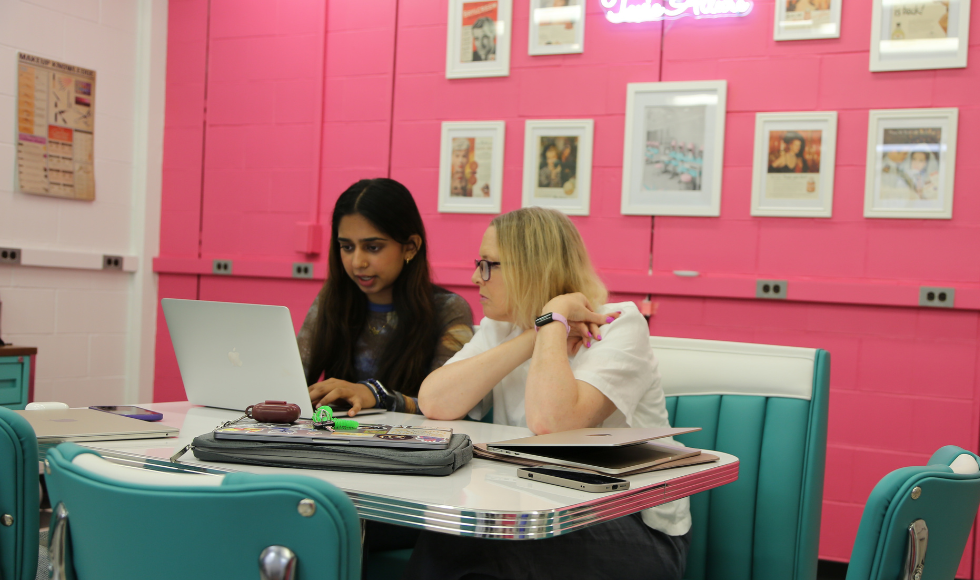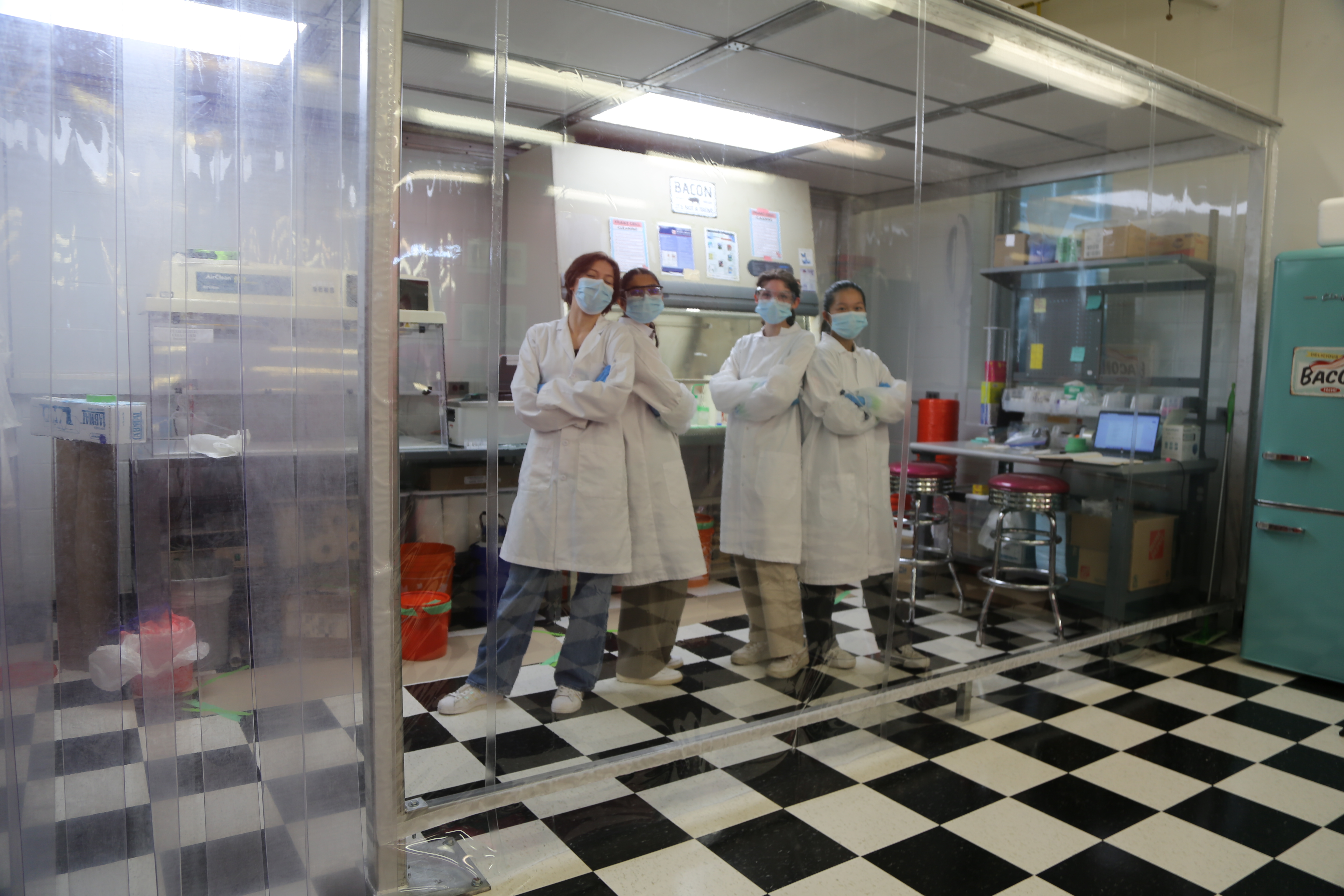There’s a hot-pink lab decked out like a ’50s diner in ABB

Fiona McNeill, right, works with undergraduate researcher Siya Sood in the Toxic Allure lab, outfitted to look like a 1950s diner. (All photos by Jay Robb, Faculty of Science)
BY Jay Robb, Faculty of Science
July 25, 2024
Professor Fiona McNeill’s lab was moving and she didn’t know whether to laugh or cry.
It’s not that she was giving up prime real estate — she was leaving a windowless, cramped and crowded space cursed with unreliable air conditioning.
It’s that the space McNeill was moving into — in the basement of the Arthur Bourns Building — hadn’t changed hands since 1968, and a lot of equipment, supplies and miscellanea had accumulated over a quarter century — along with a few structural surprises.
But when life throws you a lemon, look to students to give it a squeeze. They’d long joked about how McNeill’s lab — which tests the absorption of lead by running experiments on ethically sourced pigskin from a local butcher — was like a diner that served a whole lot of bacon.
So McNeill used the move as the opportunity to redesign her lab from scratch. Eight months later, with help from Facility Services, she created a 1950s diner: Toxic Allure — a fun space for serious science.
“I wanted a lab that feels welcoming to students from the moment they walk through the doors and makes them want to stick around after they’ve run their experiments,” says McNeill.
“This is the most fun research space I’ve ever worked in.”
McNeill has dedicated her career to studying the effects of lead on people’s health.
Among the research she’s most proud of is her work showing that women exposed to high levels of lead experience early menopause. Her research into the toxicity of white lead makeup from the 18th century generated international headlines.
For the past four years, she has been exploring the underlying mechanism of lead absorption into skin. It’s still a mystery, and McNeill says we still underestimate just how much lead our bodies are absorbing.

Bacon? No thanks
Ads for lead-based makeup and hair dye from 1950s magazines were framed and hung on the wall beneath a neon sign for “Toxic Allure”.
The room’s original scuffed and worn flooring had to be replaced, so McNeill went with black and white checkboard laminate. She salvaged two metal desks and a cabinet that were so old they were now vintage and had them painted a Tiffany blue. She found a retro fridge in the same colour, where her team now stores frozen pigskin samples.
One entire wall was painted hot pink — “Facility Services kept checking to see if I was absolutely sure about the colour.”
The lab leans hard into the bacon motif with signs on every wall. Experiments are run on pigskin that’s kept at 37 Celsius, the average human body temperature. It doesn’t take long for the samples to smell — and not in a way that sets off a craving.
“Very few students keep eating bacon at the end of their time in the lab.”


The centrepiece of the lab is an aluminum-edged Formica table with matching chairs and a bench seat. It’s where students set up their laptops, analyze data and huddle with McNeill to work through their research projects.
“The retro dinette brings our group together.”
All that’s missing is a jukebox and soda fountain.

Once the clutter had been cleared out, McNeill realized she was moving into a much bigger space. She dedicated half of the lab to a custom-built clean room.
It’s important to keep environmental lead from getting in and contaminating their samples. The room’s clear plastic walls let students sitting at the diner table watch their colleagues at work.
Science Communications (Taylor’s version)
McNeill says she got an enthusiastically warm welcome from research colleagues, who looked forward to students injecting some life back into that part of the building.
“I’m not sure they were counting on quite this much life, energy and Taylor Swift music.”
The lab is full of Swifties, says Siya Sood, an Integrated Science student who’s going into her second year after spending the summer working with McNeill.
She’s the second youngest of the nine students in the lab — McNeill has also taken on a high-school intern. Sood found about the job opportunity after joining the mailing list for the Faculty of Science’s Office of Undergraduate Research.
It can be intimidating and overwhelming for undergrads to walk into a research lab, Sood says, but “that’s not what you feel here in Dr. McNeill’s lab. It’s changed my perspective of what it’s like to be in science.”

The diner vibe matches McNeill’s approach to supervising and mentoring students, she says.
“It’s such a supportive, welcoming and fun culture. Dr. McNeill makes a point of learning what you’re interested in and then finding ways to incorporate that into her lab.”
McNeill, who is a big believer in science communication, held an open house to show off the extreme lab makeover, serving slices of pie to more than 100 faculty, staff and students, while each of her students delivered a two-minute talk about their research.
“It’s important that students know how to talk about their research and get comfortable and confident working with journalists and media relations professionals,” she said.
Toxic Allure may be the only 1950s diner that includes a ring light on a tripod, which students use when creating TikTok and Instagram content about the lab’s research.
And should any of those videos get liked and shared by T-Swift, the noise coming out McNeill’s basement lab just might get heard across the entire campus.


